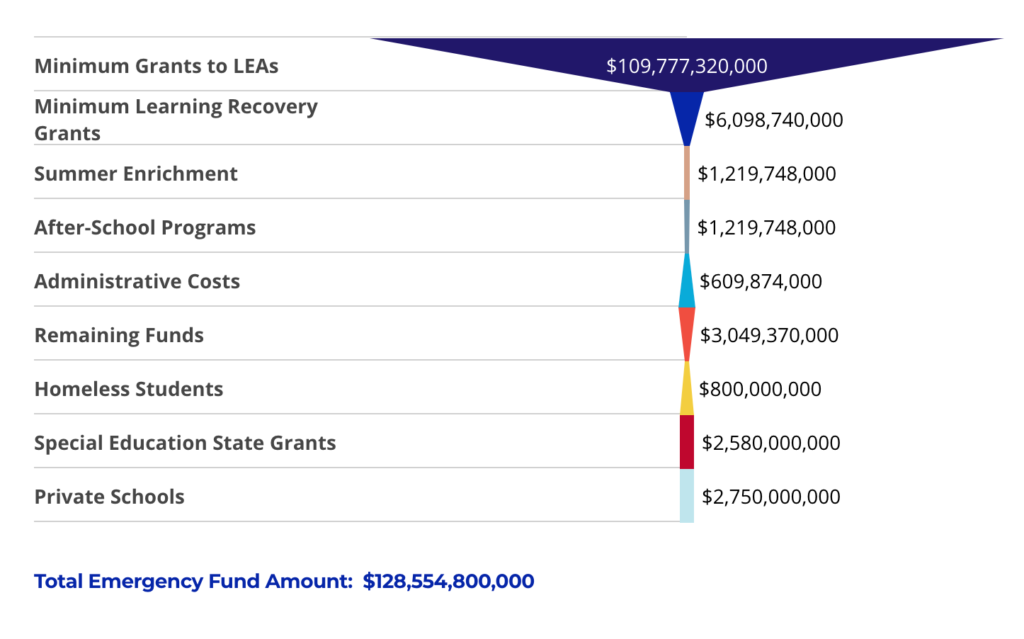American Rescue Plan – Education Payouts
- Posted by Marlena Livingston
- Date April 1, 2021

What does the American Rescue Plan mean for Educators and Students?
Below is a summary of both K-12 and Higher Education Provisions of the Bill:
Summary of Education Provisions

Alliance For Excellent Education:
Funding for Education
• $123 billion for K–12 state education agencies (including $800 million for homeless children)
• $40 billion for institutions of higher education
• $2.75 billion to governors for private schools
• $3 billion for the Individuals with Disabilities Education Act
Distribution of K–12 Funding (Elementary and Secondary School Emergency Relief Fund)
The amount of funding allocated to each state and district will be based on the relative amount of Title I funding the state or district receives. States are required to subgrant at least 87.5 percent of their funding to school districts (including charter schools that are considered school districts).
State Set-Asides
States are required to set-aside funds from their grants for the following purposes:
• 5% to address learning loss
• 1% for evidence-based, comprehensive afterschool programs
• 1% for evidence-based summer enrichment
Local Educational Agency Use of Funds
Within 30 days of receiving funding, school districts must publish a plan to reopen schools for in-person instruction. In addition, at least 20% of funds must be used to address learning loss through evidence based interventions that respond to students’ academic, social, and emotional needs. The remaining funds can be used for any allowable use under the Elementary and Secondary Education Act, Individuals with Disabilities Education Act; Carl D. Perkins Career and Technical Education Act; and Adult Education and Family Literacy Act. Funds also can be used for such purposes as
• coordinating with public health departments;
• conducting activities to address the needs of students from low-income families, children with disabilities, English learners, racial and ethnic minorities, students experiencing homelessness, and foster care youth;
• purchasing educational technology (including hardware, software, and connectivity as well as assistive technology or adaptive equipment);
• summer learning, and supplemental after-school programs;
• mental health services;
• addressing learning loss;
• school facility repairs to reduce risk of virus transmission and support student health;
• implementing public health protocols including policies in line with guidance from the Centers for Disease Control and Prevention for school-reopening; and
• implementing activities to maintain the operation and continuity of services and to employ existing staff.
Maintaining State Funding
To receive funding, states must provide at least as much funding for K–12 and higher education in fiscal years 2022 and 2023 as a proportion of the state’s overall spending (averaged over fiscal years 2017, 2018, and 2019). However, this requirement can be waived by the Secretary of Education. In addition, states and districts must comply with new Maintenance of Equity requirements that prevent state and local funding cuts from disproportionately impacting high poverty districts and schools.
Broadband
$7.2 billion is provided to the E-rate program for home internet access and connected devices.
The American Rescue Plan allocates $7 billion to purchase technology (both devices and WiFi connectivity) for students to aid in their digital learning interactions. This is the single largest one-time investment ever in the Federal Communications Commission’s E-rate program—and the only appropriated investment in the program’s history—specifically to help schools ensure all K-12 students have an internet connection or a device adequate for distance learning at home so they can participate in remote learning.
The funding is specifically directed at low-income students and students with disabilities. In order to be best prepared for future out-of-school learning time, there will also be funding directed at planning to provide technology to all students, and supporting eligible schools and libraries in providing, among other things, eligible connected devices, internet service, and hotspots to students and teachers for internet use at home.
NY Times Summary
Here are some of the main provisions:
-
About $110 billion goes directly to school districts. States and districts that serve low-income students will get more money per student. About $22 billion of this money must go to address lost learning. The rest is pretty much up to the district.
-
Summer enrichment programs and after-school programs both will get at least $1.2 billion.
-
Programs and grants for students with disabilities will get about $2.6 billion.
-
Private schools that serve a “significant” number of low-income students will get about $2.8 billion. Our colleague Erica Green wrote an illuminating piece about how this provision sneaked into the bill.
-
The plan also earmarks $800 million to identify and support homeless students.
In earlier stimulus packages, K-12 schools received about $70 billion, a financial defibrillator that many districts plan to use to stave off deep budget cuts or retrofit buildings for in-person learning. Mike Griffith, a school finance expert at the Learning Policy Institute, estimates that the new injection of money comes to about $2,400 per student, weighted toward students in low-income, low-performing districts. (In total, the stimulus bills and rescue plans provide schools with an extra $4,000 per student, Griffith found.)
You may also like
-
BN Bookstore Bulk – Volume Quote Form
17 March, 2022Thank you for your interest in ThinkEDU! This form is for departments or individuals looking to make a BULK or Volume purchase for their school or college. Please fill out …
-
Certification Quote Request Form
6 September, 2021Thank you for your interest in Autodesk Certifications! Please fill out the form below and tell us what you are looking for. We will respond back to you as quickly …
-
Covid-19, Distance Learning and You!
31 March, 2020At ThinkEDU, we consider our customers and employees full partners in our success. With the challenging coronavirus (COVID-19) affecting communities and families around the world, at ThinkEDU, our priority remains …

